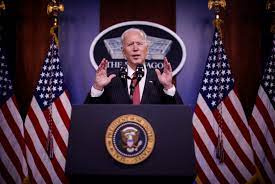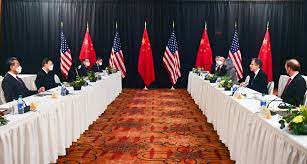By John Ubaldi, “Ubaldi Reports”
Speaking before the United States Senate and House of Representatives President George Washington stated, “To be prepared for war is one of the most effective means of preserving peace.” This statement has been lost on progressive Democrats who want to fundamentally reduce the size of the U.S. military in the mistaken belief that this will ensure peace and tranquility.
As President Biden prepares to unveil his first defense budget on May 3rd, 50 House Democrats have urged the president to “substantially” reduce the Pentagon budget by upward of $700 billion.
“While we are heartened that your administration is not contemplating expanding the Pentagon’s already inflated budget, our new Democratic majorities in Congress along with your administration should go further,” the lawmakers wrote Tuesday in a letter to Biden. “Rather than requesting a flat Pentagon budget, we urge you to seek a significantly reduced Pentagon topline.”
Ubaldi Reports Podcast on U.S. Defense Budget
In the letter, the 50 House progressive Democrats urged the president that undoing “part of undoing the damage” the Trump administration has caused is to begin by re-evaluating spending priorities and this begins with the Department of Defense.
“Hundreds of billions of dollars now directed to the military would have greater return if invested in diplomacy, humanitarian aid, global public health, sustainability initiatives, and basic research,” they wrote. “We must end the forever wars, heal our veterans, and re-orient towards a holistic conception of national security that centers public health, climate change and human rights.”
Right now, President Biden is contemplating spending on defense at the same level that was spent in 2021. The question Democrats have never asked or contemplated is how would adversaries, such as Russia and especially China, respond if the United States substantially reduced its defense budget?
What would the reaction be from our allies, especially those in Asia?
One only has to remember the Spanish philosopher George Santayana who stated the aphorism, “those who cannot remember the past are condemned to repeat it.”
Three times in the 20th century America both substantially reduced the military and at the same time gave conflicting signals on our intentions and in each case this led to conflict. The first was when the United States reduced the military and gave conflicting signals of our intentions after World War One. With the conclusion of the war to end all wars, the U.S. substantially gutted its military and gave signals of ambivalence as war raged in Europe and Asia in the late 1930’s and early 1940’s which eventually led our adversaries to believe we would not fight; leading Japan to attack America at Pearl Harbor.
The second occurrence was after the Second World War, when the Truman administration massively reduced America’s armed forces with his Secretary of State Dean Acheson giving an address at the National Press Club on January 12th, 1950, mentioning America’s defensive perimeter didn’t include Korea. Many have speculated this omission was the pretense for North Korea’s invasion of South Korea.
The final example was in 1990, when U.S. Ambassador to Iraq, April Glaspie, gave the impression the U.S. was uninterested or gave no opinion on Baghdad’s border dispute with Kuwait. Many have speculated this gave the green light for Iraqi Dictator Saddam Hussein to invade the country not fearing a U.S. response.
The current situation has America in a precarious position, as Russia seeks to regain lost territory in Eastern Europe and begin to reestablish itself as a great power, this after partnering with China to counter the United States.
America’s greatest national security threat is with China who seeks to dominate the world away from the liberal international order established by the United States at the Bretton Woods agreement of 1944.
Currently, China is expanding its military and militarizing the South China Sea, eradicating Democracy in Hong Kong, enslaving Uyghur Muslims into concentration camps, and using every nefarious business tactic to include cyber espionage of U.S. intellectual properties costing the U.S. upward of $500 billion a year.
Former Vice Chief of Staff of the U.S. Army General Jack Keane stated in an interview that President Biden is saying all the right things, but China perceives weakness in the president harkening back to the weakness showed by the Obama-Biden administration, and with the same officials back in charge of U.S. national security; Beijing doesn’t fear America!
Whatever anyone believes of President Donald Trump, the Chinese believed he would act decisively; this isn’t the case with Biden.
Keane stated that China has been massively building up its military and holds a quantitative edge over the U.S. military in many areas including hypersonic missiles even as the qualitative advantage is still with the United States, but we are still at a severe disadvantage.
Various U.S. military exercises in direct competition with China have America losing, and losing with a high degree of casualties in both personnel and in capital ships.
Early this month Commander of U.S. Indo-Pacific Command Admiral Philip S. Davidson testified before the Senate Armed Service Committee on U.S. Indo-Pacific command posture and stated, “The greatest danger for the United States in this competition is the erosion of conventional deterrence. A combat-credible, conventional deterrent posture is necessary to prevent conflict, protect U.S. interests, and to assure our allies and partners. Absent a convincing deterrent, the People’s Republic of China (PRC) will be emboldened to take action to undermine the rules based international order and the values represented in our vision for a Free and Open Indo-Pacific. The combination of the PRC’s military modernization program and willingness to intimidate its neighbors through the use, or threatened use of force, undermines peace, security, and prosperity in the region.”
The greatest flash point is Taiwan!
Admiral Davidson referenced a speech that General Secretary Xi Jinping’s gave at a 2019 New Year’s speech made it clear that Beijing is focused on achieving unification as a part of the PRC’s national plan of rejuvenation, stating “We do not promise to renounce the use of force and reserve the option to use all necessary measures.”
During Admiral Davidson’s testimony before the Senate Armed Services Committee he reiterated that “the PRC represents our greatest strategic threat. Its rapidly advancing capabilities and increasingly competitive posture underscore its drive to become a regionally dominant, globally influential power. Beijing is growing increasingly confident, and PRC leaders have demonstrated a willingness to accept friction to pursue a more expansive set of political, economic, and security interests. This growing assertiveness is particularly acute concerning sovereignty disputes, as Beijing seeks to steadily and incrementally shift the regional status quo to their advantage.”
The admiral gave recommendations on what is needed to prevent a conflict, and any student of history knows nations are never attacked when they are strong, and currently China believes America and the Biden administration is weak. One only has to look at the recent exchange between America and China’s top national security leaders in Anchorage, Alaska, where China showed unpresented belligerence toward the United States, as they don’t fear America.
From China’s vantage point America is more engaged in woke culture as the Biden administration is more concerned with granting sexual reassignment surgery for military personnel, new hairstyles, maternity flight suits, and perusing extremism in the ranks then returning the U.S. military to its core mission of provide the military forces needed to deter war and to protect the security of our country.
Even the United States Special Operations Command is not immune from this woke culture where they just unveiled its “Diversity and Inclusion Strategic Plan” and with it it’s first-ever diversity and inclusion officer.
Since 2016, the Pentagon has spent $8 million to treat 1,500 transgender troops, but how does this help the United States? How does this help the United States in a potential conflict with China, Russia, Iran or any other adversary?
Democrats would have the U.S. military transformed and recalibrated to investing in diplomacy, humanitarian aid, global public health, sustainability initiatives, and basic research then in actual its core mission of warfighting.
A previous historic analogy was after World War II, President Truman and his Secretary of Defense Louise Johnson advocated and implemented sharp reductions in military spending that initiated severe cuts in the Navy, Army and Marine Corps in favor of strategic bombing initiated by the Air Force as the lead in force protection.
The defense reductions after World War II and change in military strategy left the United States unprepared for the conventional conflict it found itself in when the Korean War broke out just 10 months later, with President Truman shocked that the U.S. was ill-prepared to conduct a naval blockade around the Korean peninsula, as the other military branches were just as ill prepared as the Navy. This unpreparedness and change in military strategy cost thousands of American lives in the early stages of the Korean War.
For the U.S. military to adhere to its core mission it will have get a handle an reform its corrupt and outdate acquisition and procurement systems so it can focus on its core mission of providing the military forces needed to deter war and to protect the security of our country.
In the past decades the pentagon wasted billions on weapons systems that never lived up to costly price tag. In an Armed Forces Journal article, “Purge the Generals,” Lieutenant Colonel Daniel Davis cited a short list of Pentagon failures:
- The RAH-66 Comanche armed reconnaissance helicopter (launched in 1991 and canceled after $6.9 billion spent)
- The XM2001 Crusader mobile cannon (launched in 1995 and canceled after $7 billion spent)
- The Future Combat Systems (launched in 2003 and canceled after $20 billion spent)
All branches of the armed forces face this systematic problem of weapons failures without receiving the tangible results as advertised.
One only has to examine the Defense Department decision in 2011, when it cancelled the Marine Corps’ expeditionary fighting vehicle after spending $3 billion. What about the Navy’s Littoral Combat Ship, which was designed to protect coastal regions, had a slew of cost overruns, the Navy wanted to build 30 of these ships costing $200 million each, only four have been built with a price tag now approaching $1 billion each.
The example of these ships was not overly impressive, with one of the ships the USS Freedom, developing a crack in its hull during sea trials. Now, there are concerns about its sustainability in combat.
To understand how the Department of Defense procurement and acquisition system is broken, just look the enormous cost overruns for the Joint Strike Fighter, commonly known as the F-35.
Each variant of the aircraft to be used by the Marine Corps, Navy and the Air Force has enormous costs associated with the aircraft: $148 million each for the Air Force, $337 million each for the Navy and $251 million each for the Marine Corps. Those costs, however, keep on rising.
Challenges to the national security of the United States are unprecedented and the Biden administration needs to address them, but if history is any indicator nations are not threatened when they are strong only when they are weak, and the perception perceived by are adversaries especially China that President Biden and America is weak.
This harsh reality is dangerous for America! Can Biden reverse this perception or will he cater to the progressive elements of the Democratic Party?




Leave A Comment
You must be logged in to post a comment.